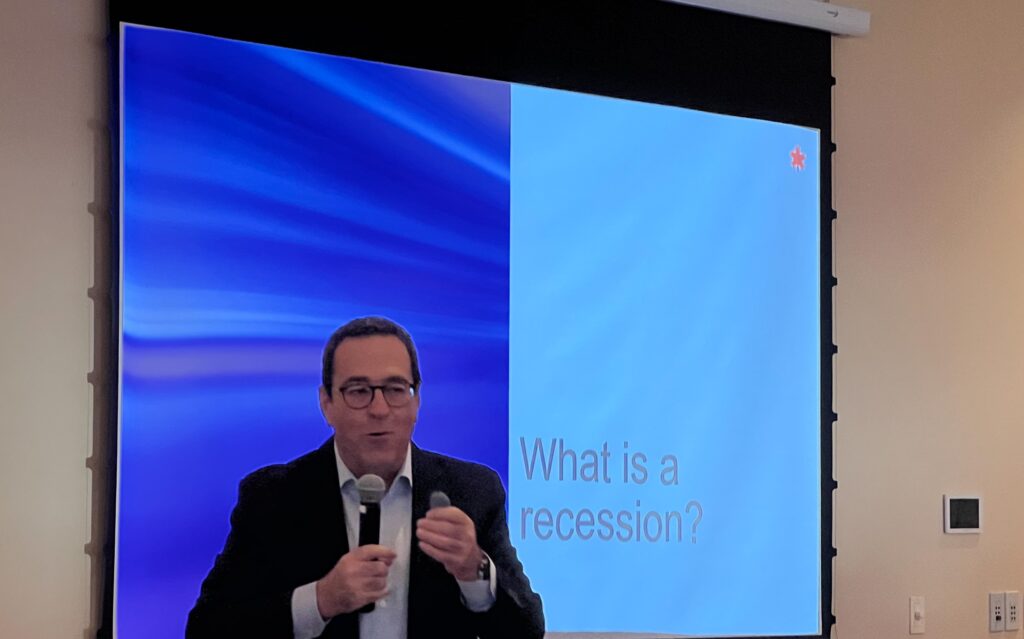Since the pandemic, Canadian consumers and entrepreneurs emerged with optimism on returning to pre-COVID 19 times. Unfortunately, continued rising prices, geopolitical tensions, and a wave of changes on societal values and beliefs all dictate this optimism in a different light than the average Canadian may have had hoped for. Inflation, and higher and more volatile costs are becoming a new norm. There is great economic uncertainty, but BDC (Business Development Bank of Canada) remains focused on bringing clarity to how these factors will impact entrepreneurs and consumers alike.
Still, the question remains: Is this an active recession, or are we entering a recession?
The answer is neither, and BDC’s Vice President and Research Chief Economist Pierre Cléroux shared some valuable insight at this year’s 2023 Business Sector Trends event, hosted by the Burlington Chamber of Commerce.

Cléroux provides clarity on this, and according to his presentation, 2020 brought on a recession as a result of the pandemic, and 2021 and 2022 saw quite the recovery. However, this celebrated recovery also brought a wide array of challenges: supply chain disruptions, labour shortages, and high inflation. To top these challenges off, the last 18 months or so saw high interest rates across the country. Needless to say, the last three years have been quite the wild ride economically speaking.
What can we expect for the next 12 months?
Cléroux believes that we will be finally returning to a more stable economic situation in 2024, but before we get there, it might be a bit of a bumpy ride — a sentiment that has been shared by a number of economists to date.
Interest rates have increased rapidly in an effort to bring inflation back to a more stable rate of 2%, according to Cléroux — all this in hopes of slowing down the economy.
His findings do suggest that after all of these rate increases, the economy appears to be finally slowing down, says Cléroux. After a record-high inflation rate of 8% in 2022, the inflation rate has now reduced to 4%, which suggests that the system employed to slow the economy down is working. While we’re not yet at that 2% inflation rate, we are getting closer, he says.
However, food inflation is still high, coming in at 6.9%, which continues to be problematic for many families across the country.
“We don’t believe that the Bank of Canada will need to increase the interest rate anymore because the economy is really slowing down,” says Cléroux. “The next [interest rate announcement] will probably stay at the same level, because the economy has slowed down so much, and the risk of increasing the interest rate could bring the economy into a recession, and nobody wants that.”
Cléroux does believe that while the interest rate will likely not increase, it will also likely not reduce until mid-2024.
To answer the big recession question, Cléroux feels that this is more of a soft landing and not a recession. The Canadian economy is currently flat, with reduced exports and reduced consumerism. There is a growth projected of 1.3% in 2023, and likely of similar rates in 2024, but to suggest it to be a recession would be inappropriate given what the research data show, according to Cléroux. This is more of a controlled slow-down by the Bank of Canada because that is what the Bank of Canada has intended to do, but mid-2024 should see some momentum for improvement.
There are reasons to be optimistic though, says Cléroux.
First, consumers are able to absorb these interest rate increases for the most part — but that is a very subjective statement to posit. Secondly, total business profit in Canada has reached a high of $400 million in 2022. While profits are slowing down and interest rates have been increasing, in terms of the level of business profit overall, businesses look to be in good position, and are cash-rich, says Cléroux. Finally, immigration is going to support economic growth in the country.
Debt to disposable income ratio, however, is said to be the highest in British Columbia, and second highest in Ontario, and that is a direct result of the cost of real estate and mortgage rates in these provinces. Cléroux says it is important to understand those rates in the current context, as these provinces are not spending disposable income on travel, but rather on housing, so when interest rates increase, things like retail sales are extensively impacted in these provinces.

Cléroux did touch on housing prices, noting that the average price of a home in Ontario has increased by 40% since 2019 and hit a peak just before interest rates started rising. As the interest rates increased, prices went down. He does continue to believe that until those interest rates are reduced, which he projects will happen closer to mid-2024, real estate prices will continue to remain stable as we have seen them in the last several months.
The economy is slowing down, which is not a surprise, says Cléroux, because the economic strategy is working, and as a result, Canadians are starting to see the inflation rate reducing.
Cléroux’s presentation was followed by a question-and-answer period with the Chamber’s Terry Caddo, as well as questions from the audience.
The 2023 Business Sector Trends hosted by The Burlington Chamber of Commerce, and presented by BDC was held on September 28, 2023, at the Burlington Golf and Country Club.




